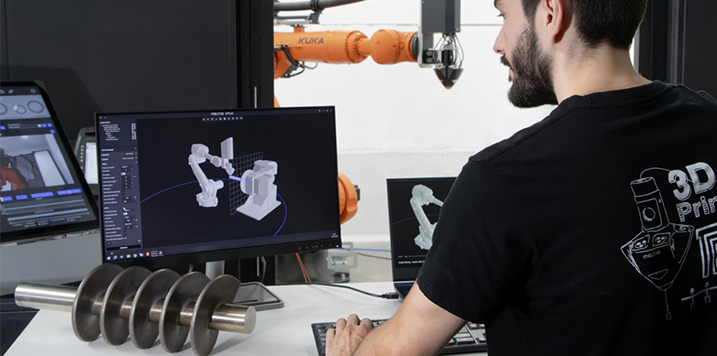 14 December, 2023
14 December, 2023Meltio has introduced two innovations to enhance its 3D printing systems for creating reliable and large-scale parts from various metallic materials. The company addresses industrial applications by utilizing a robotic arm equipped with an integrated head developed by Meltio for 3D printing. As a Spanish multinational, Meltio is both a manufacturer and developer of its exclusive laser wire 3D printing technology for metal, which is created and patented in its unique factory in Linares, Jaén.
In response to the growing global demand, Meltio has witnessed increased adoption of its Meltio Engine Robot Integration head on robotic arms for 3D printing and repairing metallic parts using laser wire additive manufacturing technology. Commonly used metals include stainless steels, titanium, nickel alloys like Inconel, and tool steels. To meet the rising industrial sector demand, Meltio has launched two user-friendly and integrable innovations. The Meltio Space toolpath generator software simplifies the design of metallic parts, providing a user-friendly interface and comprehensive functions compatible with robotic arms from ABB, Kuka, Fanuc, and Yaskawa.
This software, designed for integrating the Meltio Engine robot and the Meltio Robot Cell turnkey solution, offers an intuitive interface for flat, non-flat, and variable extrusion toolpaths. It includes 2-axis workpiece positioner interpolation, kinematic simulation, collision checking, and cell configuration. Meltio Space goes beyond the limitations of traditional 3-axis systems, introducing a 6-axis robotic manipulator and 2-axis workpiece positioners, expanding possibilities for metal 3D printing. The software's coordination, multi-axis toolpath generation, and enhanced design freedom enable users to create complex, customized, and highly detailed metallic parts.
Meltio Space includes presets with recommended 3D printing material profiles and parameters. With a strong focus on user experience, it offers a fully personalized customer journey centered on seamless integration between Meltio Engine and Meltio Space. The software provides custom Meltio print profiles included in the Meltio material portfolio. Thanks to its intuitive design, users can quickly adapt and leverage the benefits of robotic additive manufacturing (AM) without requiring robotics or programming knowledge.
The Meltio Space robotic cutter utilizes a virtual model of the robot's actual movement, allowing users to simulate the robot's kinematics for precise and accurate 3D printing. Additionally, the cutter performs collision checks with the printing part, minimizing the risk of errors or damage during the additive manufacturing process.
Meltio Robot Cell
The second recent innovation from Meltio is the Meltio Robot Cell, a turnkey solution designed to enhance the performance of a robotic arm converted into a system for securely, reliably, and highly accurately 3D printing metallic parts. This solution offers a competitive delivery time of 4 to 6 weeks.
As a developer and manufacturer of patented Direct Energy Deposition (DED) 3D printing technology, Meltio aims to be a reliable solution for industries worldwide adopting Meltio's laser wire metal 3D printing solutions to reduce costs and improve manufacturing processes. The Meltio Robot Cell includes a standard ABB robotic arm within the Meltio Robot Cell, enabling 3D printing and repairing of large, dense, and reliable metal parts from a build plate in a factory setting, as well as adding features or repairs to existing parts.
The defined volume and workspace in the Meltio Robot Cell meet all manufacturing needs using their industrial-level additive manufacturing technology to maximize the use of Meltio's metallic 3D printing head. The robot and positioner are installed on a self-supporting platform, as well as in a secure enclosure for laser safety along with the Meltio Engine, Meltio Space, and accessories.
With the Meltio Robot Cell, Meltio satisfies most applications required by industries and integrators for industrial metal 3D printing. The Robot Cell is a plug-and-play system, requiring a single electrical power source and a single inert gas supply. Standard environmental conditions apply, and the cell should be placed in a controlled environment protected from sun exposure and dust. This solution allows customers to receive a ready-to-use product for robotic metal 3D printing.
Certified and tested to operate with an ABB robotic arm as the standard configuration, the Meltio Robot Cell is suitable for all industries. It represents an evolution of integrating the Meltio Engine robot as a baseline production model, enabling industries to incorporate 3D printing of parts using the Meltio head integrated into a robot.
Meltio's primary goal with the launch of the Meltio Robot Cell is to provide industries of all types the opportunity to manage the entire manufacturing process using their metal 3D printing technology, featuring a Meltio head integrated into a robotic arm within a secure environment, simplifying the production of parts. This new hardware system enables customers to receive a ready-to-use cell for robotic metal 3D printing, eliminating the integration process and long assembly times. The Meltio Robotized Cell has a dedicated area for each daily supply needed by the cell, requiring only connection to the inert gas and electricity supplies to start manufacturing, according to Alejandro Nieto, Meltio Engine product manager.
Source: Interempresas.
Subscribe to our newsletter. Just insert your e-mail and you will receive the latest news.